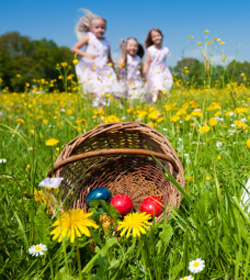The Easter egg is one of the most identifiable symbols of Easter. The egg is the symbol of fertility and new life, and the customs and traditions of using eggs have been associated with Easter for many centuries.
 In Medieval Europe, eggs were forbidden during Lent. Eggs laid during that time were often boiled or otherwise preserved. Eggs were therefore enjoyed as a part of Easter meals, and a prized Easter gift for children and servants.
In Medieval Europe, eggs were forbidden during Lent. Eggs laid during that time were often boiled or otherwise preserved. Eggs were therefore enjoyed as a part of Easter meals, and a prized Easter gift for children and servants.
From our research, Easter eggs were originally painted with bright colours to represent the sunlight of spring and after they had been painted, etched or decorated, were often given as gifts between romantic couples.
The eggs were always enjoyed by children who would love decorating and playing games with them.
There are many ways to decorate Easter eggs.
Easter Egg Games
Many games have been developed over the years using Easter eggs.
One of the most popular is the Easter egg hunt, where children of all ages will search around their house or at the local park for Easter eggs that have been left by the Easter bunny while they were asleep. Often older children will help younger children to find some Easter eggs.
Many countries also celebrate by playing a game called Easter egg roll. Children will line up at the top of a grassy hill and will roll their eggs down the hill and the person who rolls their egg the furthest, without breaking it, shall be the winner. The most famous egg roll takes place on the White House lawn every year.
Another Australian game is the Egg-knocking game. Everyone pairs up and everyone then chooses an egg. The two partners take turns tapping their partner’s egg with theirs. The first egg to crack loses and the winner goes on to challenge other winners until there is one egg left.